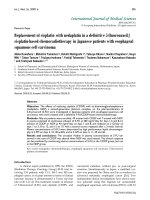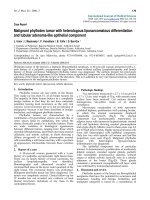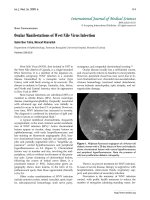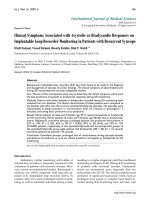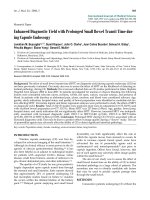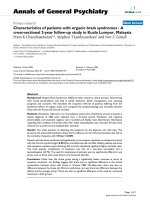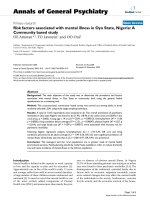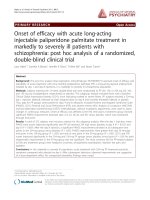Báo cáo y học: "Treat Ankylosing Spondylitis with Methazolamide"
Bạn đang xem bản rút gọn của tài liệu. Xem và tải ngay bản đầy đủ của tài liệu tại đây (797.38 KB, 7 trang )
Int. J. Med. Sci. 2011, 8
413
I
I
n
n
t
t
e
e
r
r
n
n
a
a
t
t
i
i
o
o
n
n
a
a
l
l
J
J
o
o
u
u
r
r
n
n
a
a
l
l
o
o
f
f
M
M
e
e
d
d
i
i
c
c
a
a
l
l
S
S
c
c
i
i
e
e
n
n
c
c
e
e
s
s
2011; 8(5):413-419
Short Research Communication
Treat Ankylosing Spondylitis with Methazolamide
Xiaotian Chang
1
, Xinfeng Yan
2
, Yunzhong Zhang
3
1. National Laboratory for Bio-Drugs of Ministry of Health, Provincial Laboratory for Modern Medicine and Technology of
Shandong, Research Center for Medicinal Biotechnology of Shandong Academy of Medical Sciences. Jingshi road 18877,
Jinan, Shandong, 250062, P. R. China.
2. Orthopedic Surgery Center of Shandong Qianfoshan Hospital, Jinan, Shandong, P. R. China.
3. Department of Rheumatic disease, Occupational Disease Prevention Hospital of Shandong, Jinan, Shandong, P. R. China.
Corresponding author: Xiaotian Chang, Mail address: Jingshi Road 18877, Jinan, Shandong, 250062. P. R. China. E-mail:
; Tel: +86-531-82919606 ; Fax: +86-531-82951586
© Ivyspring International Publisher. This is an open-access article distributed under the terms of the Creative Commons License (
licenses/by-nc-nd/3.0/). Reproduction is permitted for personal, noncommercial use, provided that the article is in whole, unmodified, and properly cited.
Received: 2011.03.07; Accepted: 2011.06.16; Published: 2011.07.01
Abstract
Background: Increased bone resorption and new bone information are two characteris-
tics of ankylosing spondylitis (AS). Much evidence has shown that carbonic anhydrase
inhibitors can restrain bone resorption. We had detected increased expression of carbonic
anhydrase I (CA1) in synovium of patients with AS. This study aimed to evaluate the
effectiveness and safety of methazolamide, an anti-carbonic anhydrase drug, for treating
patients with AS.
Methods: Two patients, called as S and L, were diagnosed with active AS based on
BASDAI and BASFI assessments, radiographic data and other clinical indices. They took
methazolamide tablets at a dose of 25 mg twice every day.
Results: Patient S's BASDAI score fell from 5.4 to 4.4, while patient L's BASDAI fell from
2.4 to 2. Patient S's BASFI score change from 2.7 to 2.9, while patient L's BASFI score fell
from 1.2 to 0.2. The ESR values of patient S were considerably reduced, while the ESR
value of patient L remained unchanged and in the normal range. The calcium concentra-
tion of patient S decreased from 3.05 mmol/L to 2.39 mmol/L. The CT evidence indicates
that the articular surfaces of the erosive sacroiliac joints became clearer and the area of
the calcium deposits began decreased. No significant systemic side effects were observed
in either patient.
Conclusions: The above results indicate that methazolamide was effective for active AS.
Methazolamide may improve AS symptoms by inhibiting carbonic anhydrase activity
during the processes of bone reporption and new bone formation.
Key words: ankylosing spondylitis (AS); carbonic anhydrase I (CA1); methazolamide; bone re-
porption; new bone formation
Introduction
Ankylosing spondylitis (AS) is a chronic in-
flammatory rheumatic disease with a prevalence of
0.5–1.9% (1). Spinal inflammation, the hallmark of AS,
causes pain and stiffness that leads to progressive
spinal deformity and fusion (1). The disease usually
takes a chronic course that is characterized by bone
resorption and new bone formation with syndesmo-
phytes and ankylosis (1).
The conventional treatment for AS is mainly
based on non-steroidal anti-inflammatory drugs
(NSAIDs) and disease modifying anti-rheumatic
drugs (DMARDs). Because NSAIDs such as celecoxib
Ivyspring
International Publisher
Int. J. Med. Sci. 2011, 8
414
have a rapid effect on inflammatory symptoms, these
drugs are the most commonly used class of medica-
tion in treating the pain and stiffness associated with
spondyloarthritis. In severe cases of AS, NSAIDs may
only be partially effective or the side effects may be
too severe to continue their use. In this case, a doctor
may prescribe DMARDs such as sulfasalazine to re-
lieve severe symptoms of the disease (2-4). Currently,
tumor necrosis factor alpha (TNF-a) blockers are
recommended for AS patients with insufficient im-
provement under conventional treatment. All three of
the well-known TNF alpha inhibitors (infliximab,
adalimumab and etanercept) have been shown to be
highly effective at treating not only the arthritis of the
joints but also the spinal arthritis associated with AS
(5). Despite the diversity of conventional treatments
available for the treatment of AS, no optimal treat-
ment plan has emerged to date (6). The current drugs
are also used for rheumatoid arthritis (RA), juvenile
RA, psoriatic arthritis and lupus (7). NSAIDs,
DMARDs and TNF alpha inhibitors control AS
symptoms by inducing an anti-inflammatory re-
sponse. These drugs do not seem to have much in-
fluence on bone resorption and new bone formation
in AS (8). For patients with AS, the future of success-
ful treatment lies in the development of new phar-
macological interventions capable of altering the
fundamental disease course.
Recently, we applied a proteomics approach to
identifying novel AS-specific proteins by comparing
the expression profiles of synovial membranes from
patients with AS, patients with rheumatoid arthritis
(RA), and patients with osteoarthritis (OA). Proteins
extracted from synovial tissues were separated by 2-D
electrophoresis, and the proteins with significantly
higher expression in the AS samples were subjected to
MALDI-TOF/TOF-MS analysis. The proteomics ap-
proach revealed significantly increased expression of
carbonic anhydrase I (CA1) in the synovial mem-
branes of patients with AS. Immunohistochemistry
and western blotting analysis confirmed the above
findings. ELISA detected a higher level of CA1 in
synovial fluids from patients with AS than in the RA
and OA samples (9). In vitro experiments by other
groups indicated that CA1 catalyzes the generation of
HCO
3
–
through hydration of CO
2
, which then com-
bines with Ca
2+
to form a CaCO
3
precipitate (10, 11).
The formation of calcium salt crystals is an essential
step during ossification. Over-expression of CA1 in
the synovium of AS patients may promote improper
calcification during new bone formation, an im-
portant feature of AS. Thus, we suggested that car-
bonic anhydrase inhibitors such as acetazolamide and
methazolamide could be effective treatments for AS.
Methazolamide, a sulfonamide derivative, has
been used to treat glaucoma for many years and is
approved by the US FDA and China FDA. As a car-
bonic anhydrase inhibitor, methazolamide reduces
the rate of fluid formation in the inner eye, presuma-
bly by slowing the formation of bicarbonate ions,
which causes a subsequent reduction in sodium and
fluid transport (12). Much evidence has shown that
carbonic anhydrase inhibitors can restrain bone re-
sorption (13-15). In the current study, we treated AS
with methazolamide. We enrolled two patients with
AS at the active stage in which new bone formation
and bone resorption are occurring. Our goal was to
assess the effectiveness and safety of methazolamide
in patients with AS.
METHODS
Two patients, referred to as patient S and patient
L, were enrolled in this study. The study was ap-
proved by The Ethics Committee of Shandong
Academy of Medical Sciences. Their symptoms ful-
filled the modified New York criteria for AS (16). They
had histories of AS for 12 years and 3 years, respec-
tively. The patients were substantially impaired by
back pain and spinal immobility. Physical examina-
tion revealed the heart, lungs and abdomen to be
normal. Their eyes were normal without acute ante-
rior uveitis. Routine laboratory tests were within the
normal range except for erythrocyte sedimentation
rate (ESR) in patient S. The ESRs of patient S and L
were 36 mm/h and 12 mm/h (reference: 0-20 mm/h),
respectively. Analyses to detect RF and anti-cyclic
citrullinated peptide (anti-CCP) antibodies were both
negative. The calcium concentration of patient S was
3.05 mmol/L, which is higher than normal range
(2.1-2.7 mmol/L). We measured disease activity using
the Bath AS disease activity index (BASDAI), which is
a questionnaire that assesses fatigue; neck, back and
hip pain; peripheral joint pain and swelling; discom-
fort; and severity and duration of morning stiffness
(17, 18). The BASDAI consists of a 1 through 10 scale
(1 being no problem and 10 being the worst problem)
that is used to assess the five major symptoms of AS.
The resulting 0 to 50 score is divided by the five
symptoms to give a final 0 – 10 BASDAI score. The
BASDAI scores of patients S and L were 5.4 and 2.4,
respectively. We also measured physical function of
the two patients using BASFI (Bath ankylosing
spondylitis functional index). The BASFI is a physical
function questionnaire that evaluates dressing, bend-
ing, mobility, standing, stairs and full-day activities
(19). The higher the BASFI score, the more severely
the patient’s functioning is limited by their AS (1 be-
ing no problem and 10 being the worst problem). The
Int. J. Med. Sci. 2011, 8
415
BASFI scores of patients S and L were 2.7 and 1.2,
respectively. We examined sacroiliac joints of the pa-
tients with computed tomography (CT) and plain
x-ray film. The results revealed bilateral sacroiliitis
with sclerosis and narrowing of the sacroiliac joints.
One sacroiliac joint of patient S became bony fusion.
The articular surfaces were blurred and seemed ser-
rated. Small erosions were observed at the corners of
the vertebral bodies in the spine, indicative of ear-
ly-stage spondylitis. The above observation indicates
that patients S and L had active AS at stage II, based
on the protocol of Braun et al. (20). Table 1 summa-
rizes the information regarding the two patients.
These two patients had previously had unsatisfactory
therapy with at least one NSAID. The patients had
also been treated with DMARDs such as sulfasalazine
and methotrexate. These therapies had been discon-
tinued at least six months before the first use of
methazolamide.
This study was designed to examine efficacy and
safety of oral methazolamide over a period of 12
weeks. The patients took a 25-mg methazolamide
tablet twice every day. The data collected every
month included the BASDAI, the BASFI, ESR, im-
munoglobulin A, immunoglobulin G, immunoglobu-
lin M and calcium ion concentration. At the end of the
treatment, sacroiliac joints of the patients were ex-
amined with CT.
Written informed consent was obtained from the
patient for publication of this case report and any ac-
companying images. A copy of the written consent is
available for review by the Editor-in-Chief of this
journal.
Table 1. Baseline characteristics of the patients with AS
pa-
tients
gen-
der
age(year
s)
disease
histo-
ry(years)
radio-
graphic
grade
BASDA
1
BASF
1
S man 28 12 stage II 5.4 2.7
L man 39 3 stage II 2.4 1.2
RESULTS
After 12 weeks of therapy with methazolamide,
patients S and L showed obvious signs of improve-
ment as assessed by the BASDAI and BASFI. The total
score BASDAI of patient S fell from 5.4 to 4.4, whereas
the BASDAI of patient L fell from 2.4 to 1 for the first
months, although the BASDAI rebounded to 2 at the
third month following the treatment. Obvious im-
provements in fatigue, morning stiffness and total
back pain were observed in the two patients. How-
ever, symptoms of peripheral joint pain and localized
tenderness turned to more serious for patient L at the
third month following the treatment. The physical
functioning of the two patients also showed im-
provement. The BASFI of patient S changed from 2.7
to 2.9, while that of patient L fell from 1.2 to 0.2. Fig-
ure 1 and Figure 2 summarize the above results. Both
patients increased their physical exercise from the
second month of the treatment, when they got im-
provement with the disease. The ESR value of patient
S was considerably reduced, while the value of pa-
tient L did not change and remained in the normal
range. The IgM level of patient S declined signifi-
cantly from 2.32 g/L to 1.86 g/L after 3 months’
treatment. The decline was especially improved at the
first month following the treatment. The level of IgM
of patient L did not change significantly and remained
in the normal range after the treatment. The IgG levels
and the IgA levels were increased for the two patients,
although IgG level and the IgA level was considerably
declined at the first month of the treatment for patient
S. In addition, the calcium concentration of patient S
fell from 3.05 mmol/L to 2.39 mmol/L, while the level
of patient L remained in the normal range. Figure 3
summarizes the above results.
Figure 1. Measuring total scores of BASDAI (A) and BASFI (B)
of AS patients with treatment of methazolamide.
Int. J. Med. Sci. 2011, 8
416
Figure 2. Measuring each index of BASDAI and BASFI of AS patients with treatment of methazolamide. A and B show BASDAI
levels of patient S and L, respectively. 1 represents fatigue, 2 spinal pain, 3 peripheral joint pain and swelling, 4 areas of
localized tenderness, 5 severities and duration of morning stiffness. C and D show BASFI levels of patient S and L, respec-
tively. 1 represents putting on your socks or tights without help or aids, 2 bending from the waist to pick up a pen from the
floor without aid, 3 reaching up to a high shelf without help or aids, 4 getting up from an armless chair without your hands
or any other help, 5 getting up off the floor without help from lying on your back, 6 standing unsupported for 10 minutes
without discomfort, 7 climbing 12-15 steps without using a handrail or walking aid, 8 looking over your shoulder without
turning your body, 9 doing physically demanding activities, 10 doing a full day’s activities whether it be at home or at work.
Int. J. Med. Sci. 2011, 8
417
Figure 3. Measuring ESR (A), IgG (B), IgA (C) and IgM (D) levels of AS patients with treatment of methazolamide.
Figure 4. CT results of sacroiliac joints of patient S (1) and patient L (2) before (A) and after (B) the treatment of
methazolamide. The evidence indicates that the articular surfaces of the erosive sacroiliac joints became clearer and the
area of the calcium deposits began decreased.

